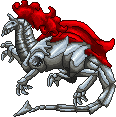Need an account? Register.
 The Armor Drake
The Armor Drake
Back to Encyclopedia
The Armor Drake

70 Clicks

100 Clicks

150 Clicks

General Information
Armor dragons are said to be the result of an enchantment becoming a wild species. These dragons are often studied by mages hoping to learn summoning magic , as they are regarded as a perfect example of a successful and possibly overly successful summon.
Armor drakes are one of the few summoned creatures to have a stable population outside of the Castle. This is more due to their ability to breed true and to a lack of natural predators than to any particular knack for survival on their part. They are susceptible to rain, snow, rust, falling in ponds, falling off cliffs, tripping and falling, and getting stuck trying to squeeze through too-dense brush or too-small openings. Armor drakes are also spectacularly bad parents, which is why armor drake eggs are disproportionately common in the Creche.
Armor drakes are one of the few summoned creatures to have a stable population outside of the Castle. This is more due to their ability to breed true and to a lack of natural predators than to any particular knack for survival on their part. They are susceptible to rain, snow, rust, falling in ponds, falling off cliffs, tripping and falling, and getting stuck trying to squeeze through too-dense brush or too-small openings. Armor drakes are also spectacularly bad parents, which is why armor drake eggs are disproportionately common in the Creche.
Egg Information

10 Clicks

20 Clicks

30 Clicks

40 Clicks

50 Clicks

60 Clicks

This egg has a large metal piece attached to it.
Armor drake eggs are sturdier than they look. They have to be, as armor drakes are indifferent parents at best and crush more eggs than they successfully raise. An egg can even potentially survive being stepped on by a careless parent, though the resulting hatchling will be frail and undersized, even as an adult. At the castle, the main threats to an armor drake egg are excessive moisture and anything that might be tempted to steal or nibble on the shiny metal plates.
Baby Information

This hatchling seems to not be anything but a suit of armor. It is incredibly clumsy and often pieces of it fall off.
The best companion for a baby armor drake is another baby armor drake, as even the young ones are gentle giants and have no idea of their true strength. A clumsy hatchling can severely injure its mage caretaker, and though it may seem guilty afterwards, that's no cure for broken bones. It's best to interact with a baby armor drake cautiously, as little as possible, and with proper protective gear.
Teen Information

This hatchling seems to not be anything but a suit of armor. It is incredibly clumsy and often pieces of it fall off. Its grown more and it seems to have taken a cloak into its suit. It also is less clumsy and less prone to falling apart.
One sign of impending adulthood in armor drakes is the hunt for just the right cloak. In the wild, they will nibble a piece off the cloak of any grown armor drake that stands still for long enough. At the castle, they're a menace to clothing. Once set in place, the fabric scrap becomes an integral part of the drake, growing as the drake does and healing if torn. The cloak can regrow as long as even a few threads are left, but cannot be replaced if completely destroyed.
Adult Information

Your hatchling has grown and it seems to be an enchanted piece of armor instead of a true dragon. Your other magical dragons are wary of this creature, especially since its origins of summoning are unknown. Any attempts to probe it for its magical focal end up in a location in nowhere.
Grown armor drakes like to accessorize with a cloth plume. While the cloak can provide some protection in a fight, the plume is purely ornamental. In the wild, cloak and plume are usually gathered from the same adult drake and usually match, but given a choice, armor drakes prefer brightly-colored plumes. This can be a good way to use up scraps of fabric that would otherwise go to waste. The gift of a plume is often the last significant interaction a mage has with their armor drake. Though some do form strong bonds with their caregivers, far more will just wander off one day, never to return.
Extra Info Provided by Mathcat